Table of Contents
Welcome to Kizworld, your ultimate guide to unlocking the world of parkour. Discover the art of finding the best parkour spots and environments that ignite your passion and push your limits. Whether you're an experienced traceur or just starting your parkour journey, this comprehensive guide will equip you with the knowledge and insights to locate ideal training grounds that match your skills and aspirations. Prepare to elevate your parkour experience and embark on an exhilarating journey of movement and creativity.
How to Find the Best Parkour Spots and Environments: A Comprehensive Guide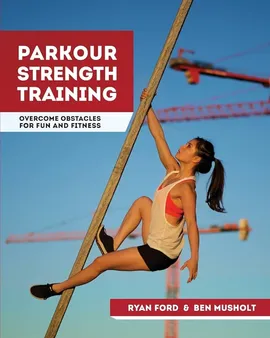
I. How to Find the Best Parkour Spots and Environments
How to Find the Best Parkour Spots and Environments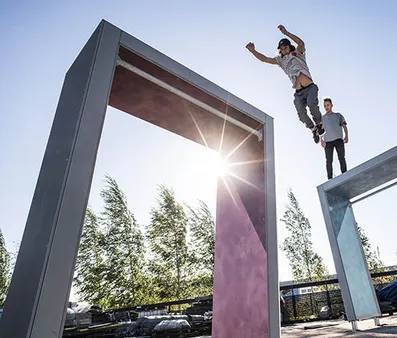
Factors to Consider in Choosing a Parkour Location
- Accessibility and Proximity: - Choosing a location close to home or easily reachable by public transportation or car can ensure regular access for consistent training.
- Safety: - The area should be free from hazards, sharp objects, or uneven surfaces that could lead to injuries.- It's recommended to seek permission from property owners or local authorities before training in an area.
- Suitability for Parkour: - The environment should offer various obstacles and elements suitable for parkour practice, such as walls, rails, benches, and other structures that allow for jumping, climbing, and vaulting.
Exploring New Locations
- Consulting Parkour Communities: - Engagaging with local parkour groups, practitioners, or online forums can provide valuable insights and recommendations for suitable training spots.
- Exploring Urban Environments: - Urban settings often offer diverse structures, abandoned buildings, and unique landscapes that are ideal for parkour training.- However, safety precautions and permission from property owners should always be prioritized.
- Venturing into Natural Settings: - Natural environments, such as forests, parks, and hills, can provide challenging terrain and obstacles for parkour, offering a unique training experience.- Adhering to park rules and being mindful of the environment are essential.
Examining Online Resources
- Parkour Spot Databases and Maps: - Numerous online platforms offer comprehensive databases and maps of parkour spots, obstacles, and training areas worldwide.- These resources allow users to discover new locations, explore different cities, and connect with other practitioners.
- Social Media and Video Sharing Platforms: - Social media platforms and video-sharing websites are excellent sources of inspiration and information about parkour spots.- By following parkour athletes and enthusiasts, one can discover new training grounds and learn about their experiences.
- Local Parkour Forums and Groups: - Participating in local parkour forums and groups can provide valuable recommendations and hidden gems that might not be easily accessible through other sources.- Forums often offer discussions, photos, and videos showcasing the best parkour spots in a particular region.
Taking Safety Precautions
- Warming Up and Stretching: - Before engaging in parkour training, it's crucial to warm up properly and stretch the muscles to reduce the risk of injuries.
- Wearing Protective Gear: - Using appropriate protective gear, such as knee and elbow pads, helmets, and gloves, can minimize the impact of falls and protect the body from abrasions.
- Respecting the Environment: - Parkour practitioners should always respect the environment they train in, leaving no trace of their presence and minimizing any potential damage to the surroundings.
"Parkour is not about being the best; it's about being better than you were yesterday." - David Belle
II. Choosing the Right Location
Choosing the Right Location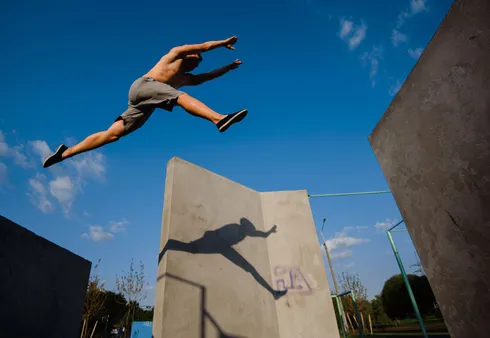
Selecting the perfect location for your parkour practice is crucial, as it sets the foundation for a safe and constructive experience. Consider aspects such as obstacles and their suitability for your skill level, as well as the availability of adequate space. Safety should be your top priority, and choosing a location that minimizes potential hazards is essential. Additionally, think about the accessibility of the site and how easily you can reach it. If you're a beginner, finding a spot with softer surfaces and fewer obstacles is advisable, to reduce the risk of injury.
It's often a good idea to choose a location that is specifically designed for parkour or similar activities. Look for locations that are popular amongst parkour enthusiasts, such as skateparks, outdoor fitness parks, or abandoned urban spaces. These locations usually have already been assessed for safety and suitability, and may even offer additional amenities like ramps or rails.
Factor | Considerations |
Safety | Look for a location with minimal hazards, such as sharp objects or excessive traffic. Soft surfaces like grass or mats are preferable. |
Obstacles | Choose obstacles that are appropriate for your skill level. Beginners should start with smaller and less challenging obstacles. |
Accessibility | Make sure the location is easily accessible and within a reasonable distance from your home or training facility. |
Space | Ensure that the location has enough space to accommodate your training needs. You should have enough room to safely perform your tricks and moves. |
Popularity | Consider the popularity of the location among other parkour enthusiasts. If it is frequented by experienced practitioners, you can learn from their techniques and share ideas. |
Remember that your choice of location can significantly impact the overall quality of your parkour experience. Take your time to find a spot that meets your needs and allows you to progress safely and confidently.
Also, it's important to be aware of your surroundings and the activities in the area. If you're practicing in a busy park, for instance, be mindful of other people and make sure you're not obstructing their activities. Keeping a respectful and safe distance from others is always a good practice.
Here's a related post you might find helpful: How to Find the Best Parkour Spots and Environments
III. Assessing the Safety of a Spot
Assessing the Safety of a Spot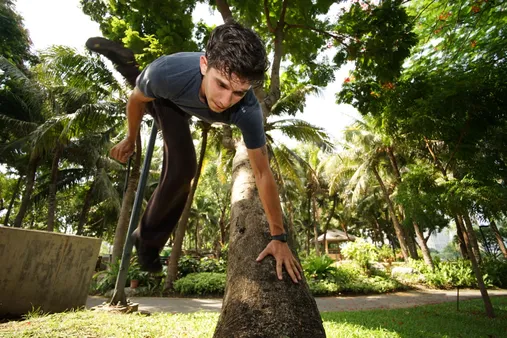
Evaluate the Landing Zones
- Look for clear, obstacle-free landing areas.
- Check for potential hazards like rocks, roots, or uneven surfaces.
- Ensure the landing zones are large enough to accommodate your intended jumps or tricks.
Inspect the Take-Off Points
- Examine the surfaces of take-off points for grip and stability.
- Clear away any loose debris or slippery materials.
- Pay attention to the height and angle of the take-off points relative to the landing zones.
Consider the Surrounding Environment
- Be aware of the presence of obstacles like trees, fences, or buildings in the vicinity.
- Check for electrical wires or other potential hazards overhead.
- Ensure there's enough space for you to move around and perform your parkour moves safely.
Discovering Suitable Environments for Parkour
Pay Attention to the Surface Conditions
- Choose spots with hard, stable surfaces like concrete or asphalt.
- Avoid surfaces that are too soft, slippery, or uneven.
- Check for any cracks, holes, or other irregularities that could pose a risk.
Assess the Visibility and Lighting
- Ensure the spot has good visibility during the time you plan to train or perform.
- Look for areas with adequate natural or artificial lighting.
- Be cautious of spots with poor visibility or limited lighting.
Consider the Noise Level
- Choose spots that are relatively quiet and free from excessive noise.
- Avoid areas near busy roads, construction sites, or other sources of loud noise.
- Respect the noise levels and regulations of the area.
Identifying Optimum Parkour Locations: Evaluating the Landscape
IV. Making the Most of Your Parkour Session
Making the Most of Your Parkour Session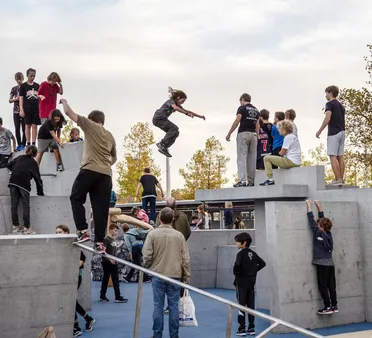
Mastering the Basics: A Foundation for Success
Before embarking on complex maneuvers, it's crucial to master the fundamental parkour techniques. These include proper landing, rolling, and vaulting. By solidifying these basics, you'll build a strong foundation for more advanced movements and minimize the risk of injury. Check out our comprehensive guide on mastering basic gymnastics skills for a deeper understanding of these essential techniques.
Table: Essential Parkour Techniques for Beginners
Technique | Description |
|---|---|
Landing | Learn how to land safely and absorb impact to prevent injuries. |
Rolling | Master the art of rolling to dissipate momentum and protect yourself from falls. |
Vaulting | Develop the skill of vaulting over obstacles with precision and control. |
Safety First: Ensuring a Positive Experience
Parkour involves inherent risks, making safety a paramount concern. Always warm up before your session to prepare your body for the physical demands of parkour. Wear appropriate clothing and footwear to minimize the risk of injury. Choose training environments that are safe and free from hazards. Remember, pushing your limits is important, but never compromise your safety.
List: Essential Safety Tips for Parkour Enthusiasts
- Warm up thoroughly before each session.
- Wear appropriate clothing and footwear.
- Choose safe training environments.
- Never push yourself beyond your limits.
- Train with experienced traceurs or in a reputable parkour gym.
Etiquette and Respect: Upholding the Parkour Community
Parkour is a community-driven activity, and respecting fellow traceurs and the environment is essential. Always be mindful of your surroundings and avoid causing damage to property or disturbing others. Be open to learning from more experienced traceurs and share your knowledge with those just starting out. Remember, parkour is about personal growth and pushing boundaries, but it's also about fostering a positive and supportive community.
Quote: "Parkour is not just about overcoming obstacles; it's about overcoming yourself." - David Belle, founder of parkour
V. Conclusion
As you embark on your parkour journey, remember that the pursuit of excellence is a continuous process. Stay informed about new developments, engage with the community, and prioritize safety above all else. Embrace the challenges and opportunities that each parkour spot presents, and let your creativity and passion guide you towards new heights. With dedication and perseverance, you'll discover that the best parkour spots are not just physical locations, but also states of mind where you can push your limits and achieve greatness.